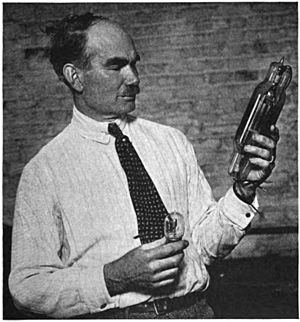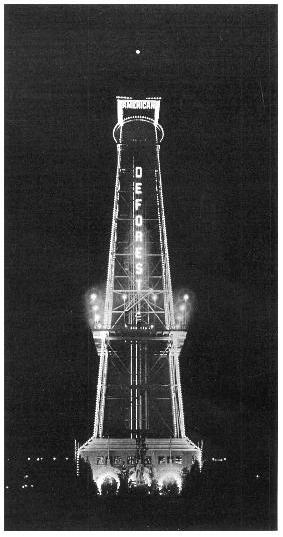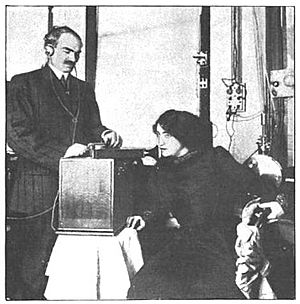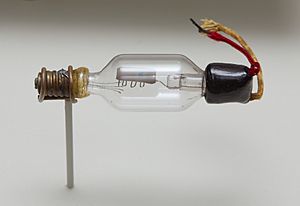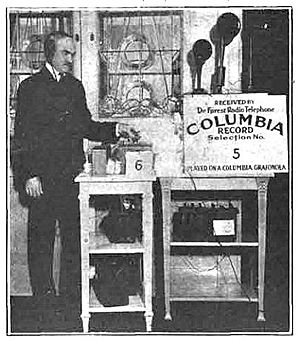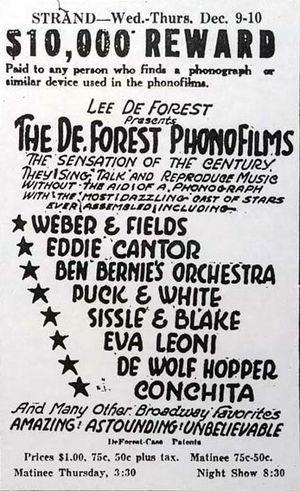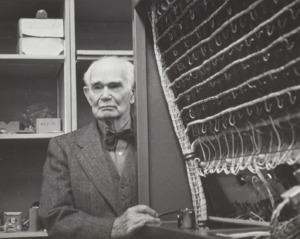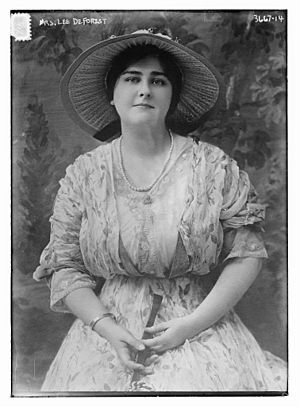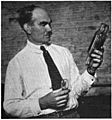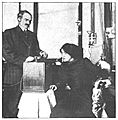Lee de Forest facts for kids
Quick facts for kids
Lee de Forest
|
|
|---|---|
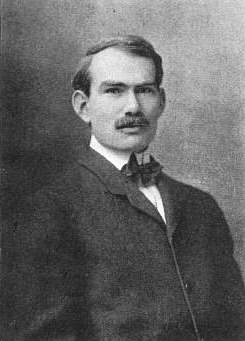
Lee de Forest c. 1904
|
|
| Born | August 26, 1873 Council Bluffs, Iowa, U.S.
|
| Died | June 30, 1961 (aged 87) Hollywood, California, U.S.
|
| Alma mater | Yale College (Sheffield Scientific School) |
| Occupation | Inventor |
| Known for | Three-electrode vacuum-tube (Audion), sound-on-film recording (Phonofilm) |
| Spouse(s) |
Lucille Sheardown
(m. 1906; div. 1906)Mary Mayo
(m. 1912; div. 1923)Marie Mosquini
(m. 1930) |
| Relatives | Calvert DeForest (grandnephew) |
| Awards | IEEE Medal of Honor (1922) Elliott Cresson Medal (1923) IEEE Edison Medal (1946) |
Lee de Forest (born August 26, 1873 – died June 30, 1961) was an American inventor. He was a very important pioneer in the world of electronics. He created the first useful electronic amplifier. This invention was the three-element "Audion" triode vacuum tube in 1906.
His invention kicked off the Electronic Age. It made radio broadcasting and long-distance phone calls possible. It also led to the development of talking motion pictures. Lee de Forest held over 300 patents worldwide. He was known for making and losing four fortunes.
Despite some challenges, he received many honors. These included the 1922 IEEE Medal of Honor. He also got the 1923 Franklin Institute Elliott Cresson Medal. In 1946, he received the American Institute of Electrical Engineers Edison Medal.
Contents
- Early Life and Education
- Becoming the "Father of Radio"
- American DeForest Wireless Telegraph Company
- Radio Telephone Company
- The Amazing Audion Tube
- Working at Federal Telegraph
- DeForest Radio Telephone Company
- Phonofilm: Sound on Film
- Later Life and Legacy
- Awards and Recognition
- Personal Life
- Quotes
- Patents
- Images for kids
- See also
Early Life and Education
Lee de Forest was born in 1873 in Council Bluffs, Iowa. His father was a minister. In 1879, his family moved to Talladega, Alabama. His father became president of Talladega College. This school welcomed all students, including African-Americans. Lee spent his youth mostly isolated from the local white community. He had close friends among the black children in town.
Preparing for College
De Forest attended Northfield Mount Hermon School for two years. This was in Massachusetts, starting in 1891. In 1893, he enrolled at Yale University's Sheffield Scientific School. He had a scholarship that helped him pay for his studies. He was sure he would become a famous inventor. He tried to interest companies in his inventions, but without much luck.
Yale University Years
After his undergraduate studies, de Forest continued his postgraduate work. His electrical experiments often caused power outages. He was even expelled from Sheffield for a short time. In 1898, he joined the Connecticut Volunteer Militia. However, the Spanish–American War ended before he saw action. He finished his studies at Yale in 1899. He earned a doctorate for his work on radio waves.
Becoming the "Father of Radio"
Lee de Forest is sometimes called the "Father of Radio." He even used this title for his autobiography. In the late 1800s, he believed wireless communication had a great future. But Guglielmo Marconi was already making big strides in radio. Marconi used a "coherer" for his receiver. It was slow and not very reliable. De Forest wanted to create a better system. He aimed for a detector that could hear signals and work faster.
Early Wireless Experiments
De Forest tried to get a job with Nikola Tesla and Marconi, but it didn't work out. So, he started on his own. His first job after Yale was in Chicago. There, he developed his first radio receiver. He called his improved versions "responders." He worked several short-term jobs while focusing on radio research. By 1900, he could transmit radio signals about seven kilometers (four miles).
Competing in Radio
In 1901, de Forest went to New York. He wanted to compete with Marconi in reporting yacht race results. Marconi was working for the Associated Press. De Forest worked for a smaller news agency. The race was a disaster for radio. Different companies tried to transmit at the same time. This caused a lot of interference. De Forest joked that the only successful communication was with flag signals.
American DeForest Wireless Telegraph Company
After the yacht race, de Forest stayed in New York. He wanted to find people to invest in his ideas. In 1902, he met Abraham White, who became his main supporter. White formed the American DeForest Wireless Telegraph Company. White was the president, and de Forest was the Scientific Director. The company aimed to develop "world-wide wireless."
De Forest struggled to create a new receiver that didn't copy other patents. In 1903, Reginald Fessenden showed his electrolytic detector. De Forest made a similar one, but courts ruled it copied Fessenden's.
Promoting Wireless Technology
White promoted the company with big events. "Wireless Auto No.1" was on Wall Street. It sent stock quotes loudly to attract investors. In 1904, the company set up stations in China. This allowed a war reporter to send news about the Russo-Japanese War. Later that year, a tower with "DEFOREST" in lights was built at the Louisiana Purchase Exposition. The company won a gold medal for its radio demonstrations.
The company's biggest contract was building five radio stations for the U.S. Navy. These were in Panama, Florida, Cuba, and Puerto Rico. They also installed stations along the Atlantic Coast. But the company's main goal was selling stock. Many inland stations were built just to sell more stock. They had no real use and were soon abandoned.
De Forest eventually disagreed with the company's leaders. He felt they didn't support his research enough. The company was unhappy that he couldn't create a receiver free of patent problems. In 1906, de Forest left the company that carried his name. The company was later renamed the United Wireless Telegraph Company.
Radio Telephone Company
De Forest quickly started over. He set up his own lab in New York City. The Radio Telephone Company was formed to promote his new inventions. De Forest preferred the term "radio," which was becoming popular in Europe.
Arc Radiotelephone Development
In 1904, Valdemar Poulsen showed an "arc transmitter." Unlike spark transmitters, it made steady signals. These signals could carry audio, like voices or music. De Forest created his own version of this arc transmitter. On December 31, 1906, he first sent audio across his lab. By February, he was making experimental broadcasts of music.
On July 18, 1907, de Forest made the first ship-to-shore radio calls. These were race reports for a yacht regatta on Lake Erie. The U.S. Navy also became interested. They ordered 26 arc sets for their "Great White Fleet" voyage. But the sets were later found to be unreliable.
The company built a network of radio stations along the Atlantic coast. These were for guiding ships. However, these stations didn't make much money. By 1911, the company was close to bankruptcy.
Early Radio Broadcasts
De Forest also used his arc-transmitter for early entertainment broadcasts. In 1907, Eugenia Farrar sang "I Love You Truly" from his lab. In 1908, music was broadcast from the Eiffel Tower in Paris. In 1909, his mother-in-law, Harriot Eaton Stanton Blatch, broadcast a speech supporting women's right to vote. This might have been the first public speech by radio.
More ambitious tests followed with the Metropolitan Opera House in New York. They tried to broadcast live opera performances. On January 12, 1910, Tosca was broadcast. The next day, Italian singer Enrico Caruso was heard. On February 24, Mme. Mariette Mazarin sang from Carmen. These tests showed that live opera broadcasting wasn't quite ready yet. De Forest stopped entertainment broadcasts until 1916.
The Amazing Audion Tube
De Forest's most famous invention was the "grid Audion." This was the first successful three-element (triode) vacuum tube. It was also the first device that could make electrical signals stronger. He got the idea around 1900. He thought a flickering gas flame might react to radio waves. He later found out it was just sound from his spark transmitter. But the idea of using a flame or similar device to detect radio signals stuck with him.
Developing the Audion
De Forest explored using heated, ionized gases in a glass tube. He called these devices "Audions." His first Audions had only two parts, like a diode. He patented this in 1906. Later, he added a third "control" part, called a "grid." This grid was placed inside the tube, between the other two parts. He named it a "grid" because it looked like the lines on a football field.
In late 1906, de Forest made a big breakthrough with this new grid design. He realized he had found an important new radio detector. He filed a patent in January 1907. This grid Audion was the only version that became truly useful. It later became known as the triode.
The grid Audion was the first device to amplify radio signals. It made weak signals stronger. Some people thought de Forest had just added a grid to an existing device, the Fleming valve. De Forest argued his invention was different. Courts eventually ruled that his Audion did use ideas from the Fleming valve patent. But Marconi, who owned the Fleming patent, agreed that the third electrode was a new improvement. So, they agreed to share licenses. This allowed both companies to make three-electrode tubes in the U.S.
For its first few years, the grid Audion was not widely used. It was often unreliable. But it laid the groundwork for future electronics.
Working at Federal Telegraph

In 1910, de Forest's company faced financial trouble. He moved to San Francisco. In 1911, he took a research job at the Federal Telegraph Company. This company made long-range radio systems.
Amplifying Audio Signals
De Forest worked on improving how radio signals were received. He had an idea: feed the output from one Audion into a second tube. This would make the signal even stronger. He called this a "cascade amplifier." It could link up to three Audions.
The American Telephone and Telegraph Company (AT&T) was looking for ways to boost phone signals. They saw that de Forest's device could help with long-distance calls. In 1912, de Forest showed his invention to AT&T. His Audions needed a small amount of gas to work. But AT&T's researchers found that making the tubes more empty (a "high vacuum") allowed them to work better with phone line voltages. This change turned the Audion into a modern vacuum tube.
In 1913, AT&T bought the rights to seven of de Forest's Audion patents for $50,000. De Forest needed the money. In 1915, AT&T used this invention for the first transcontinental telephone calls.
DeForest Radio Telephone Company
De Forest's previous company had problems with selling stock. In 1912, de Forest and others were charged with mail fraud. He was found not guilty in 1913. After this, he reorganized his company as the DeForest Radio Telephone Company. He set up a lab in New York City.
Selling Radio Tubes
In 1914, he sold the commercial Audion patent rights to AT&T for $90,000. De Forest kept the rights for sales to "amateur and experimental use." His company began selling "Oscillion" power tubes to radio enthusiasts. These tubes were for sending radio signals.
During World War I, his company sold a lot of radio equipment to the military. However, his company's vacuum tubes were known for being lower quality than those from bigger companies.
Restarting Radio Broadcasts
In 1915, his lab got an experimental radio license for station 2XG. In late 1916, de Forest started broadcasting entertainment again. He used his new vacuum-tube equipment, which was much better. His first show was on October 26, 1916. It promoted Columbia Graphophone Company records. The station played music nightly.
These broadcasts also advertised DeForest Radio Company products. But de Forest soon stopped the direct advertising. The station also made the first audio broadcast of election results in November 1916. Before this, results were sent using Morse code. About 2,000 listeners heard news of the presidential election.
When the U.S. entered World War I in April 1917, all civilian radio stations had to shut down. So, 2XG went silent. The ban was lifted in October 1919, and 2XG started broadcasting again. In 1920, de Forest moved the station's transmitter to San Francisco. He started a new station, 6XC, which he called the "first radio-telephone station devoted solely" to public broadcasting.
Later that year, a partner of de Forest helped newspapers set up their own radio stations. In August 1920, The Detroit News started its own radio station, WWJ.
Phonofilm: Sound on Film
In 1921, de Forest focused on developing an optical sound-on-film process called Phonofilm. He filed the first patent for this system in 1919. Phonofilm recorded sound waves as patterns of light and dark on film. When the movie was played, these patterns were turned back into sound. The sound played at the same time as the picture.
De Forest spent time in Berlin, Germany, studying other sound film systems. In April 1922, he announced he would soon have a working system. On March 12, 1923, he showed Phonofilm to the press.
In November 1922, de Forest started the De Forest Phonofilm Company. But Hollywood movie studios weren't interested. They controlled most of the movie theaters. This meant de Forest could only show his films in independent theaters. The Phonofilm Company went bankrupt in 1926.
Early Sound Films
De Forest made short films of stage performances, speeches, and music. On April 15, 1923, he showed 18 Phonofilm shorts at a theater in New York City. Starting in 1924, Max and Dave Fleischer used Phonofilm for their "Song Car-Tune" cartoons. These featured the "Follow the Bouncing Ball" to help people sing along.
De Forest also worked with Freeman Harrison Owens and Theodore Case. They helped improve the Phonofilm system. However, de Forest had disagreements with both men. Case felt de Forest didn't give him enough credit. Case then developed his own sound film system, which became Fox Movietone. Warner Brothers also introduced a competing system called Vitaphone.
By 1927, Hollywood studios started using sound-on-film systems more widely. Almost 200 Phonofilm shorts were made. Many of these are still kept in archives today.
Later Life and Legacy
In 1923, the De Forest Radio Telephone & Telegraph Company was sold. De Forest's finances were hit hard by the stock market crash of 1929. He also tried to research mechanical television, but it didn't make money. In 1934, he started a small business making diathermy machines. In 1942, he still hoped to make "at least one more great invention."
De Forest often criticized how radio entertainment developed. In 1940, he wrote an open letter saying radio had been "debased" by popular music. In 1950, his autobiography, Father of Radio, was published.
De Forest appeared on the TV show This Is Your Life in 1957. He was called "the father of radio and the grandfather of television." He had a severe heart attack in 1958 and was mostly bedridden. He died in Hollywood on June 30, 1961, at age 87. He was buried in San Fernando Mission Cemetery.
Enduring Impact
The grid Audion, which de Forest called "my greatest invention," and the vacuum tubes that came from it, were very important for 40 years. They made long-distance phone calls, radio broadcasting, and television possible. They were also used in early electronic computers. The invention of the transistor in 1948 eventually replaced vacuum tube technology. Because of his work, de Forest is considered one of the founders of the "electronic age."
His strong desire to invent helped him overcome challenges. He was independent, self-reliant, and always wanted to achieve great things. His archives are now part of The Perham Collection of Early Electronics, displayed at History San José.
Awards and Recognition
- He was a founding member of the Institute of Radio Engineers (IRE) in 1912.
- Received the 1922 IRE Medal of Honor for his invention of the three-electrode amplifier.
- Awarded the 1923 Franklin Institute Elliott Cresson Medal for his "Audion" invention.
- Received the 1946 American Institute of Electrical Engineers Edison Medal for the huge impact of his grid-controlled vacuum tube.
- Received an Honorary Academy Award (Oscar) in 1960. This was for his inventions that brought sound to movies.
- Honored with a star on the Hollywood Walk of Fame on February 8, 1960.
- DeVry University was originally named the De Forest Training School. Its founder was a friend of de Forest.
Personal Life
Marriages
De Forest was married four times. His first three marriages ended in divorce.
- Lucille Sheardown in February 1906.
- Nora Stanton Blatch Barney (1883–1971) on February 14, 1908. They had a daughter, Harriet.
- Mary Mayo (1892–1957) in December 1912. They had a daughter named Deena.
- Marie Mosquini (1899–1983) on October 10, 1930. Marie was a silent film actress. They stayed married until his death in 1961.
Political Views
De Forest was a conservative Republican. He was strongly against communism and fascism. In 1932, he voted for Franklin Roosevelt. But he later disliked Roosevelt's policies. In 1949, he wrote to Congress. He urged them to vote against socialized medicine and other government programs. In 1952, he wrote to Vice President Richard Nixon. He encouraged Nixon to fight communism in the government.
Religious Views
De Forest grew up in a very religious Protestant home. However, he later became an agnostic. This means he believed it was impossible to know if God exists. He wrote in his autobiography that his religious beliefs changed in 1894.
Quotes
De Forest made many predictions, some correct and some not.
- "I discovered an Invisible Empire of the Air, intangible, yet solid as granite."
- "I foresee great refinements in the field of short-pulse microwave signaling, whereby several simultaneous programs may occupy the same channel... Short waves will be generally used in the kitchen for roasting and baking, almost instantaneously." – 1952
- "So I repeat that while theoretically and technically television may be feasible, yet commercially and financially, I consider it an impossibility; a development of which we need not waste little time in dreaming." – 1926
- "To place a man in a multi-stage rocket and project him into the controlling gravitational field of the moon... will never occur regardless of all future advances." – 1957
- "I do not foresee 'spaceships' to the moon or Mars. Mortals must live and die on Earth or within its atmosphere!" – 1952
- "As a growing competitor to the tube amplifier comes now the Bell Laboratories’ transistor... Yet its frequency limitations... will never permit its general replacement of the Audion amplifier." – 1952
- "I came, I saw, I invented—it's that simple—no need to sit and think—it's all in your imagination."
Patents
- U.S. Patent 748,597 "Wireless Signaling Device" (directional antenna), filed December 1902, issued January 1904;
- U.S. Patent 824,637 "Oscillation Responsive Device" (vacuum tube detector diode), filed January 1906, issued June 1906;
- U.S. Patent 827,523 "Wireless Telegraph System" (separate transmitting and receiving antennas), filed December 1905, issued July 1906;
- U.S. Patent 827,524 "Wireless Telegraph System," filed January 1906 issued July 1906;
- U.S. Patent 836,070 "Oscillation Responsive Device" (vacuum tube detector – no grid), filed May 1906, issued November 1906;
- U.S. Patent 841,386 "Wireless Telegraphy" (tunable vacuum tube detector – no grid), filed August 1906, issued January 1907;
- U.S. Patent 841,387 "Device for Amplifying Feeble Electrical Currents" (...), filed August 1906, issued January 1907;
- U.S. Patent 876,165 "Wireless Telegraph Transmitting System" (antenna coupler), filed May 1904, issued January 1908;
- U.S. Patent 879,532 "Space Telegraphy" (increased sensitivity detector – clearly shows grid), filed January 1907, issued February 18, 1908;
- U.S. Patent 926,933 "Wireless Telegraphy";
- U.S. Patent 926,934 "Wireless Telegraph Tuning Device";
- U.S. Patent 926,935 "Wireless Telegraph Transmitter," filed February 1906, issued July 1909;
- U.S. Patent 926,936 "Space Telegraphy";
- U.S. Patent 926,937 "Space Telephony";
- U.S. Patent 979,275 "Oscillation Responsive Device" (parallel plates in Bunsen flame) filed February 1905, issued December 1910;
- U.S. Patent 1,025,908 "Transmission of Music by Electromagnetic Waves";
- U.S. Patent 1,101,533 "Wireless Telegraphy" (directional antenna/direction finder), filed June 1906, issued June 1914;
- U.S. Patent 1,214,283 "Wireless Telegraphy."
Images for kids
See also
 In Spanish: Lee De Forest para niños
In Spanish: Lee De Forest para niños


